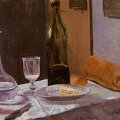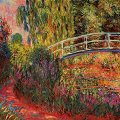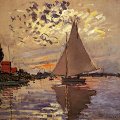Introduction
Impressionist art is based on the use of color, which has to draw the motive without resorting to line.
At the beginning of his career, Monet used dark colors, as he did in the Studio Corner marked by black shades. His painting evokes Courbet and the Realist School.
 From
1860 on, Monet abandoned dark colors and worked from a palette
limited to pure light colors. In 1905, answering a question about his
colors, he wrote: "As for the colors I use, what's so interesting
about that? I don't think one could paint better or more brightly with
another palette. The most important thing is to know how to use the
colors. Their choice is a matter of habit. In short, I use white lead,
cadmium yellow, vermilion, madder, cobalt blue, chrome green. That's
all."
From
1860 on, Monet abandoned dark colors and worked from a palette
limited to pure light colors. In 1905, answering a question about his
colors, he wrote: "As for the colors I use, what's so interesting
about that? I don't think one could paint better or more brightly with
another palette. The most important thing is to know how to use the
colors. Their choice is a matter of habit. In short, I use white lead,
cadmium yellow, vermilion, madder, cobalt blue, chrome green. That's
all."
The color analysis enabled to identify the colors he used and the binder of the paintings: poppyseed oil and linseed oil. The former dries off slower and yellows less.
The issue of black
Pure black is rarely used by the Impressionist painters. Monet obtained an appearance of black by combining several colors: blues, greens and reds. He eliminated almost completely black from his painting, even in the shadows. In the Red Boats, Argenteuil, shadows are purple.
Avoiding black was so deeply anchored in Monet's manner that when he died, his friend Georges Clemenceau would not stand the black sheet covering the coffin. He exclaimed: "No! No black for Monet!" and replaced it by a flowered material.
Colors seen by an ill eye
In 1908, aged 68, Monet was affected by cataract at both eyes, he began to loose sight. The first signs of this cataract can be found in the paintings he made in Venice in 1908.
Cataract is a progressive opacity of the crystalline lens that filters the colors. As cataract develops, whites become yellow, greens become yellow-green and reds, oranges. Blues and purples are replaced by reds and yellows. Details fade out, shapes blur and become hazy.
When his vision altered, Monet went on with working. He could know what color he used by the labels and the unvarying order he set them on the palette. "My bad sight means that I see everything through a mist," - he wrote - "Even so it is beautiful, and that's what I would like to show."
 Monet was used to
paint exactly what he saw. Gradually his paintings are invaded by reds
and yellows. Blues vanish. Details fade like in the Weeping
Willows of 1919 and the Waterlilies of 1920. The effects of
the cataract on Monet can be observed from some paintings depicting
the same motif, for instance The Japanese Bridge made in 1897
and The Waterlily Pond made in 1923.
Monet was used to
paint exactly what he saw. Gradually his paintings are invaded by reds
and yellows. Blues vanish. Details fade like in the Weeping
Willows of 1919 and the Waterlilies of 1920. The effects of
the cataract on Monet can be observed from some paintings depicting
the same motif, for instance The Japanese Bridge made in 1897
and The Waterlily Pond made in 1923.
In 1911, Monet wrote to a friend: "Three days ago, I realized with terror that I didn't see anymore with my right eye." During the next years, his left eye gradually lost its acuity, and he had to stop painting in Summer of 1922. He was then almost blind.
Nevertheless, his friend Georges Clemenceau convinced him to undergo surgery. In 1923, he could see again with his right eye, wearing special green glasses. But his vision was still altered, and he refused to undergo surgery for the left eye.
Monet resume painting as soon as 1923. The House Seen from the Roses Garden shows the effects of the operation. In this series, Monet painted either with his left eye suffering from cataract - everything is red, the sky is yellow - or with the operated eye - everything is blue.
"I see blue, I don't see red anymore, nor yellow; this bothers me terribly because I know that these colors exist, because I know that there is red, yellow, a special green, a particular purple on my palette; I don't see them anymore as I used to see them in the past, and however I remember very well how it was like."
In spite of this handicap, Claude Monet continued to paint until 1926, a few months before he died.
Claude Monet Art

|
|
More
Articles
 Art Encyclopedia A world history of art in articles.
Art Encyclopedia A world history of art in articles.
Impressionism
Claude Monet
Life and work.
Starting the Impressionism.
Colors in Claude Monet's paintings.
Best paintings.
Art
 Art Wallpapers Art image collections for your desktop.
Art Wallpapers Art image collections for your desktop.
Monet Art, $35
(250 pictures)
Degas Art, $25
(170 pictures)
Renoir Art, $39
(300 pictures)

